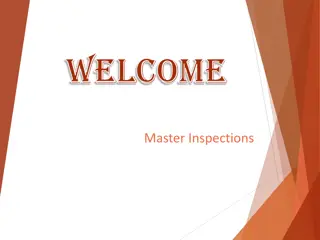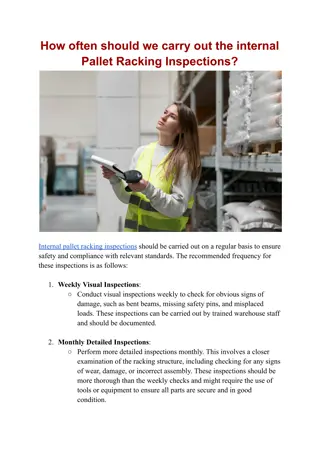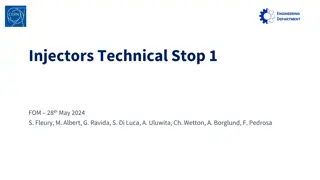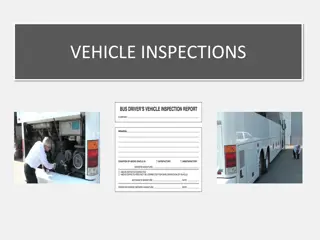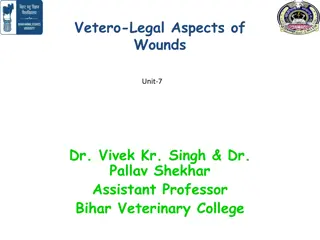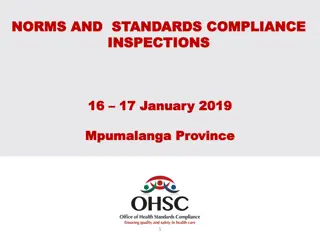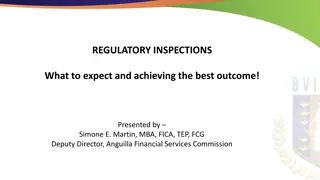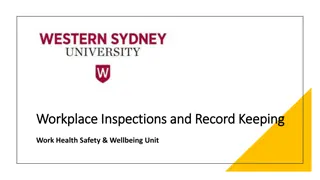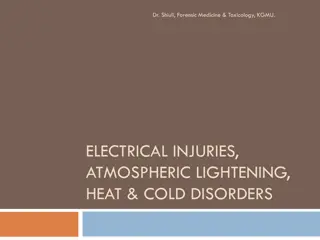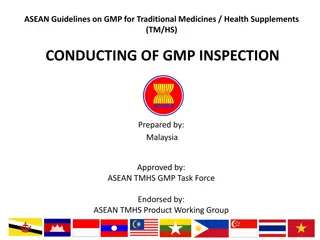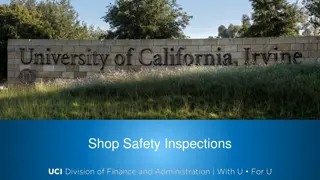Understanding Slaughtering Techniques and Post-Mortem Inspections in Animal Agriculture
This article explores slaughtering techniques in animal agriculture, emphasizing procedures such as stunning, different stunning methods, and common slaughter practices like Halal, Kosher, and Jhakta methods. It also discusses post-mortem inspections and the importance of humane treatment during the slaughter process.
Download Presentation

Please find below an Image/Link to download the presentation.
The content on the website is provided AS IS for your information and personal use only. It may not be sold, licensed, or shared on other websites without obtaining consent from the author. Download presentation by click this link. If you encounter any issues during the download, it is possible that the publisher has removed the file from their server.
E N D
Presentation Transcript
Slaughtering techniques and post- mortem inspections By: Dr. R. K. Jaiswal Asstt. Prof.-cum-Jr. Scientist Dept. of LPT Bihar Veterinary College Bihar Animal Sciences University Patna-800014 (Bihar)
Slaughtering Procedures After the animals have been rested for sufficient time, they are quietly taken to the stunning area. Animals may be facilitated through mechanical means like canvass straps or rolled plastic or prodded to move forward. However tail twisting or beating is forbidden. Slaughter animals are properly restrained before stunning or bleeding. Different types of restraints are used for different species.
Stunning It is a process to inactivate animals so that it is not able to move. It is an obligatory process with large animals. Stunning ensures that the animal is unconscious before it is slaughtered in order to eliminate pain, discomfort and stress from the procedure. Many countries have legislation that requires pre-slaughter stunning. Care should be taken not to affect the heart and it should function normally to ensure complete bleeding which ensures better meat quality. Stunning is done in special stunning pan (box with movable side wall).
Stunning methods 1. Most common method employed is striking on the head with a wooden hammer or captive bolt. However blow should not damage the frontal bones as it may cause brain haemorrhage. 2. Electrical stunning: An electric current of 75-120 volt is passed for 15-70 seconds through the hind part of the animal head in the regions of parietal boxes by puncturing the skin. This causes unconsciousness of the animals which may last for 5 min and it is enough to transfer the animal from stunning pan to bleeding runway. 3. Anesthetization: Anaesthetization may be carried out on swine using a mixture of CO2 and air in equal volume with 0.18% chloroform and the inhalation period may last for one min.
Slaughtering methods The most common methods of slaughter practiced worldwide are the Halal (Islamic), the Kosher (Jewish) and the Jhakta (Sikh) methods. 1. Halal: Halal is one of the most popular method of slaughter. This method prescribes slaughtering of animals with a sharp knife to make a swift, deep incision that cuts the front of the throat, the carotid artery, wind pipe and jugular veins but leaves the spinal cord intact. The animal is then hung upside-down and left to exsanguinate i.e drainage of blood.
The Halal slaughter requires that the name of Allah (or God) should be mentioned at the initiation of the operation. This method of slaughter ensures that the blood flows out completely from the animal. 2. Jhatka: It is an instant decapitation process limited mostly to sheep and goats and practiced in countries like India by few religious sects (hindu and sikhs). The animals are killed by a single strike of a sword or axe by severing the head.
3. Jewish Slaughter (Kosher): Kosher is the term applied to the procedures and techniques of slaughter practiced under the Jewish faith. In Hebrew language, Kosher means fit to be used as food. Under this method of slaughter, the animals in fully conscious state are killed and bled thoroughly by one clean stroke of the knife. Animals are however hoisted and shackled first.
A 16-inch (40.6 cm) razor-sharp steel knife called the chalaf is stuck into the throat by a trained slaughterer, the schohet, in an operation in which the animal is killed and bled at the same time. Skinning is made from the chest down to the level of the belly, and the chest is cut open first for inspection and later evisceration.
Bleeding Bleeding is a procedure in the slaughter process which is performed by cutting jugular vein in the neck and carotid artery in order to allow blood to drain from the carcass, resulting in the death of the animal from cerebral anoxia. The bleeding knife should be continuously sharpened as a blunt knife may prolong the incision and damage the cut ends of the blood vessels. This may result in premature clotting and blockage of the vessels thus delaying the bleeding process.
A prolonged delay in bleeding could result in the animal regaining consciousness. bleeding may also result in an increase in blood pressure causing the blood vessels to rupture and haemorrhage of muscle. The extra blood in the tissues may lead to meat getting decomposed quickly. Incisions should be therefore swift and precise. In poultry, sheep, goats and ostriches, the throat is cut behind the jaw. The delayed
Skinning After successful bleeding, first the head is skinned, separated from the body, marked with the same number as the body and then hung on hook for post mortem examination. Skinning is a term mostly used for small ruminants and the method of skinning is known as case-on . The skinned materials are called as skins . In sheep and goats, skin is first cut around the leg to expose and loosen the tendon of the hock and used for hanging the carcass. This process is called legging.
The second step that follows is called skinning which involves removal of the entire skin and preparation of the animal body for evisceration. Skinning can be done either in the horizontal or hanging position depending on the convenience and available facilities. If animal body is in hanging position, legging is generally started at the back of the free leg by removing the skin around the hock and continued towards the toes. This exposes the tendon on the back leg and the foot is cut off at the joint above the toe.
The body skin is removed by making an opening in the front legs, cutting towards the jaw and continuing over the brisket to the naval. Once the brisket has skinned, knife is seldom used to protect the fell (a fine membrane between the skin and the carcass). This helps in improving carcass appearance and reducing surface shrinkage. This is largely accomplished by using fist/hand. After the skin has been removed, the carcass is washed and placed on a hook. In horizontal skinning the animal is placed on its back on a flat raised surface and similar process repeated.
This operation is absent in pigs, because skin is a part of the carcass. In the case of large ruminants (cattle and buffaloes), cuts are made on the skin along the mid-ventral line and also on the medial side of the limbs connecting to the respective points (sternum and pelvis) in the mid- ventral line. Skinning of large ruminants is known as flaying and the incisions made on the skins are known as rippinglines . The deskinned materials are called as hides.
Evisceration It should be carried out without damaging the internal organs or disturbing the internal surface of the carcass. Damage to the gastro-instestinal tract (GIT) may contaminate the carcass with the microorganisms. The first step in evisceration is to cut around the tied bung or rectum and free it completely from all attachments. The breastbone is then cut along the midline up to its tip. Another cut is made from the cod or udder down the midline into the breast cut.
Then the ureter connections to the kidneys are severed and the intestines loosened. The stomach and intestinal mass are removed. The liver could be detached from its connecting tissues and then pulled out along with the contents of the abdominal cavity. The gall-bladder is carefully removed from the liver so that its content does not spill out and contaminate the carcass. The pluck consisting of heart, lungs, trachea and esophagus can be pulled out as a unit. The carcass is then washed and carried manually or mechanically to the inspection area.
Carcass splitting and sizing In the slaughterhouses, 1. Carcasses of small ruminants are not split into sides or quarters 2. Carcasses of large ruminants are split into four quarters 3. Carcasses of pigs are split into two sides. Therefore, at the retail meat stalls selling buffalo meat, pork and mutton, we find quarters, sides and whole carcasses of respective animals. Carcasses are sawed by electric or pneumatic saws starting from the hind part to the central vertebrae. This facilitates transport, storage and efficient refrigeration.
Post Mortem Examination Inspection of carcass and organs by qualified veterinarians to ensure that carcass and organs are fit for human consumption. During inspection, care should be taken not to contaminate the carcass and organs from diseased animals. The knives and other instruments used for cutting and examining organs, glands and tissues should be properly sterilized before and after use. The particular sequence should be followed during post-mortem examination so that each carcass and thereof organs are checked thoroughly.
Objectives of post-mortem examination Identification of diseases of public health significance; Identification of diseases significance; Identification of residues or contaminants in excess of the levels allowed by legislation; Non-compliance with microbiological criteria; Other factors which might require the meat to be declared unfit for human consumption as in case of ritual slaughter To ensure humane slaughter of animal health
Facilities required for post-mortem examination Inspection points should have sufficient and well distributed light of 540 lux Adequate hand washing units with supply of hot and cold running water , liquid soap and towels Meat inspection knifes Sterilizers for complete immersion of knives, saws, cleavers etc. Stamping ink (solution of 1-2% of fuschine in acetic acid)
General consideration The examination must be done as soon as possible. Carcasses of beef and pork set rapidly and if the inspection is delayed especially in cold weather the examination of lymph nodes becomes difficult. Carcass and organs are to be examined methodically following a definite sequence. Healthy carcass should be examined before inspecting the diseased or suspected ones. Great care must be taken at the time of inspection particularly in cases suspected for zoonotic diseases.
The identity of carcass and its viscera should be maintained. Inspector should avoid unnecessary cuts considering the value of high quality food. One should incise the carcass in such a way that the surface of the carcass appears clean and undistorted.
Post-mortem inspection principles Visual perception: First the carcass and visceral organs should be examined visually for any visible abnormalities. Examination is done for any change of colour, atrophy, hypertrophy, neoplastic condition etc. Palpation: The organs are palpated for any change in consistency, sliminess or gelation, cyst, etc. Incisions: The organs are incised, if needed. This is done to examine any parasite inside organ, structural deformity etc.
Laboratory tests: These are done for confirmation and support the observation made by macroscopic examination. While examining the organs of carcass, lymph node of adjoining area must be examined.
Post-mortem Examination of Carcasses Large animals: In case of large animals like cattle, sequence of post-mortem examination is as follows: Head Verify the number, age and sex of the animal Inspect gums, lips and tongue for FMD, necrotic and other forms of stomatitis, actinomycosis and actinobacillosis (Palpate the tongue for the latter). Incise the internal and external masticatory muscles and tongue for Cysticercus bovis. Incise retropharyngeal, submaxillary and parotid lymph nodes for tuberculosis (TB) lesions. For sheep & goat, the lips, gums and nasal cavities should be examined for contagious ecthyma.
Lungs Examine visually and then palpate for the detection of pleurisy, pneumonia, tuberculosis, fascioliasis and hydatid cysts. Incise the bronchial and mediastinal lymph nodes and expose the lung by giving deep incision from the base to apex (for checking TB lesions). Check the tumors, abscesses etc. by palpation. Heart Examine the pericardium for traumatic or tubercular pericarditis.
Incise the ventricles of the heart and pay attention to look for petechial hemorrhages on the epicardium and endocardium and cuts in the myocardium. Flavy condition of the myocardium is indicative of septic conditions. Liver A visual examination should be made for fatty changes, abscesses, hydatid cysts, actinobacillosis etc. For examination of fascioliasis, incise thin portion of left lobe of liver and examine the contents.
For sheep and goat, lungs, heart and liver: (i) Palpate lungs, heart and liver and accompanying lymph glands for abscesses. (ii) Cut the bile duct for examining possible fluke infestation Stomach and intestines Check the serous surface of the intestine for TB lesions and actinobacillosis. Palpate the mesenteric lymph node and if necessary incise and examine the same.
Spleen Examine the surface and substance for TB lesion, anthrax, hematoma and presence of infarcts. Uterus Check for septic conditions by viewing, palpating and incising if necessary. Udder Check the supra-mammary lymph nodes by incising for the evidence of TB lesions. Check for abscesses if any.
General inspection of carcass Look for the injuries and bruises. Bruises are dark colour after 24 hours and there is watery condition after 24 to 38 hours. After 3 days, the area becomes rusty orange colour and soapy to touch. Look for inflammation, abscesses and TB lesions in the thoracic and abdominal cavities. Examine the kidneys. Incise and examine renal lymph nodes.
Post-mortem judgement Similar to ante-mortem examination, a competent veterinarian has to submit its judgment report: Fit for human consumption Unfit for human consumption or total condemnation Affected organs must be condemned while rest can be passed for human condemned). Condemned carcass/ organs should be disposed off following scientific procedure. (partially consumption
COMMON DISEASES ENCOUNTERED AND THEIR JUDGEMENT



